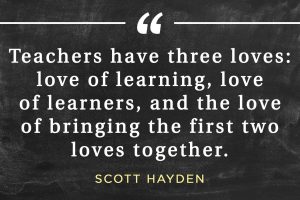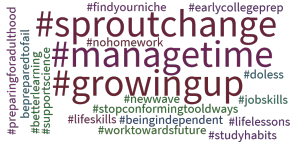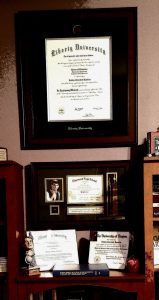#StudentsMatter

In writing Ruminations & Rabbit Trails, I briefly touched on the transformation taking place in the field of education – a transformation that is blurring the lines concerning the landscape of teaching and learning. As I stated then, now is the time to nurture that change. However, as Rosebrough and Leveratt (2011) describe,
“Many teachers have the tendency to put their heads down, noses on grindstone, and plow straight ahead through what it is they think they are supposed to be teaching. Suddenly they look up to see that not only has the subject matter changed almost overnight, but that students themselves have changed” (p. 2).
When that sudden ‘look up’ realization occurs, it can be overwhelming. It may force some educators to put their nose back to the grindstone – hiding their face in their work – not wanting to look up. It is at that moment we need to ask ourselves, “What really matters in education?”
Rosebrough and Leveratt (2011) put forth that, “What really matters in education is not what but who” (p. 8). Teaching is a human endeavor, taking a human touch. If we, as educators, chose to teach due to our content or focus on athletics or desire for advancement, we’ve truly lost our way. In a period of such transformation within the field of education, where 21st-century students bring their 21st technologies and 21st-century trauma into our classrooms, now is the time to have a clear vision – a clear purpose.
Recently, I asked a group of upperclassmen students, “Now that you are nearing the end of your high school career, what would be ‘one thing’ that you believe would have helped you prepare for NOW/college/career/life?” They were to respond with an online posting, giving a two paragraph response. Afterwards, I had students create #summaries of what they had posted. The data results are insightful and powerful. Below is one group’s #summaries:

As a rural educator with a deep commitment to the rural identity, #sproutchange speaks to me! This group of upperclassmen sees a need to #stopconformingtooldways – a desire for a 21st-century educational system that is #newwave and that #workstowardfuture.
As noted above, education is about WHO. As Rosebrough and Leveratt (2011) remind us, “Education begins with learners and their transformation” (p. 14). The voices of those learners, like my upperclassmen above, reminds us of the needed change to our educational system – one that will be transformational in their 21st-century lives. They are also a reminder of WHO is needed to make this change – US. Now is the time to #sproutchange – to nurture that transformation – because, yea, #StudentsMatter.
REFERENCES
Leverett, R. G., & Rosebrough, T. R. (2011). Transformational Teaching in the Information Age: Making Why and How We Teach Relevant to Students. ASCD.
 “Despite all of my fancy degrees, I was never an educator, only an instructor . . .” (Seaton, 1948). So were the words spoken by Prof. Edward Bell, portrayed by Edmund Gwenn (think Santa Clause in Miracle on 34th Street). It was a simple, Saturday morning movie. Yet this old film snapped me back to the realities of why I teach – why educators are so important.
“Despite all of my fancy degrees, I was never an educator, only an instructor . . .” (Seaton, 1948). So were the words spoken by Prof. Edward Bell, portrayed by Edmund Gwenn (think Santa Clause in Miracle on 34th Street). It was a simple, Saturday morning movie. Yet this old film snapped me back to the realities of why I teach – why educators are so important.